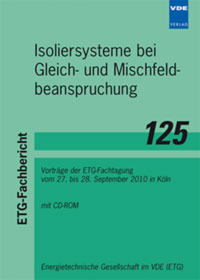Gas Insulated Systems for HVDC
Konferenz: Isoliersysteme bei Gleich- und Mischfeldbeanspruchung - ETG-Fachtagung
27.09.2010 - 28.09.2010 in Köln, Deutschland
Tagungsband: Isoliersysteme bei Gleich- und Mischfeldbeanspruchung
Seiten: 7Sprache: EnglischTyp: PDF
Persönliche VDE-Mitglieder erhalten auf diesen Artikel 10% Rabatt
Autoren:
Hama, Hiroyuki (Mitsubishi Electric Corporation T&D Systems Centre, Switchgear Department, Amagasaki, Japan)
Riechert, Uwe (ABB Switzerland Ltd., High Current Systems, Zurich, Switzerland)
Endo, Fumihiro (Energy System Research Division, EcoTopia Science Institute, Nagoya University, Nagayo, Japan)
Juhre, Karsten (Siemens AG, Power Transmission Division, High Voltage Products, Berlin, Germany)
Kindersberger, Josef (Technical University of Munich, Munich, Germany)
Meijer, Sander (TenneT TSO b.v., Arnhem, The Netherlands)
Neumann, Claus (Amprion GmbH, Dortmund, Germany)
Okabe, Shigemitsu (High Voltage and Insulation Group, Tokyo Electric Power Company, Yokohama, Japan)
Schichler, Uwe (Siemens AG, Power Transmission Division, High Voltage Substations, Berlin, Germany)
Inhalt:
Various high-voltage (HV) gas insulated switchgear (GIS) and gas insulated systems for AC and DC voltages have been developed during the past decades to provide a higher stability of the transmission networks and to allow an increase of the transmission power. Beside the UHV AC transmission the demand for reliable and economic high-voltage DC (HVDC) installations is increasing especially for long distance transmission lines. As known the dielectric behaviour of insulating materials at DC stress is different compared to the behaviour at AC or impulse voltage stress. The knowledge about the DC behaviour of both insulating gases and solid materials like insulators is essential for an optimized design and for the reliability of HVDC equipment. Moreover, high residual DC voltages (trapped charges) occur in AC gas insulated systems. These voltages have to be considered for the insulation design. For example after opening of a circuit-breaker (CB) followed by a disconnector switch (DS) opening operation, trapped charges remain on the load side of the DS. These high DC trapped charge voltages have usually very long decay times and must be taken into consideration. Therefore, DC insulation properties are also important for highly developed AC systems. Fundamental insulation characteristics at various voltage wave shapes have been studied at many laboratories. The DC insulation studies and the technical development for the practical equipment are needed to maintain and to improve the insulation performance. Especially, it is essential to understand the insulation behaviour of insulators and surfaces as well as the particle motion at DC voltage stress, including the firefly phenomenon occurring at DC. A clear understanding of the particle motion and the motion control are very important to enhance the insulation reliability. The CIGRÉ Task Force D1.03.11 has collected all information and prepared a Technical Brochure: "Gas Insulated Systems for HVDC: DC Stress at DC and AC Systems". The Technical Brochure will be published in 2010. The following items were the key aspects of the study of the CIGRÉ Task Force and are described in detail in the Technical Brochure: Insulation characteristic of gas gap and insulator surfaces; Insulation design of insulators for DC applications; Charge accumulation characteristics on insulator surfaces and methods for the measurement; Particle motion and measures for particle trapping; Partial discharge (PD) detection and analysis in HVDC gas insulated systems; Residual DC voltages and insulation characteristic at DC pre-stress occurring in AC systems. This paper gives an overview about the investigations and presents some important results more in details. Especially, the dielectric behaviour of the gas insulation as well as the behaviour of insulators at DC voltage stress and at superimposed voltage stress will be discussed, referring to the latest worldwide research.


